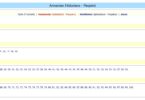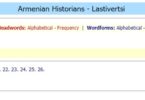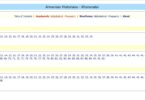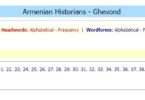An Essay on the English Translation of Yeznik by Blanchard and young
Thomas J. Samuelian
In Armenian tradition, translation is holy work. This is particularly apt to remember when considering this new English translation of one of the Holy Translators, Yeznik Koghbats’i[1]. Yeznik was one of the circle of fifth-century Armenian clerics who under the tutelage of Sts. Sahak and Mesrop learned the new Armenian alphabet and used it to translate the Holy Book, and in Yeznik’s case, to create a work of theology. His YeghtsAghandots’, The Refutation of the Sects, (which Monica J. Blanchard and Robin Darling Young, have called, “On God,” following L. Maries’s functional classification of the book as a “De Deo”), is the earliest extant, sustained effort of the Armenian mind to attempt to understand the essence of God. Yeznik’s book survives today only in the single manuscript, Matenadaran No. 1097, dated 1280 A.D. copied by the scribe Lusser at the University of Gladzor, and rediscovered in 1902.[2] However, the first publication of 1763 in Smyrna, was based on what appears to be a second, now lost manuscript, by the scribe Gevorg, that was used by the medieval professor, Tovma Metsopets’i (1378-11446), who also left notes in the margins of Matenadaran No. 1097.[3] Since its rediscovery, Yeznik’s book has been published in several critical editions and translated into German, French, Modern Eastern Armenian, Modern Western Armenian, Russian, Italian, and twice into English, first in an abridgement for the Armenian Church’s Christian Education Program in the United States, and now in the translation that is the subject of this review.
Blanchard and Young’s book is divided into two parts: an historical/critical introduction and a translation. Without explanation, Blanchard and Young choose to use the French edition as the basis of their translation, rather than the more recent critical edition by Minassian which takes into fuller account the two recensions of this work.[4] One would expect, at a minimum, that after the scholarly effort of nearly a century, when the full text was finally presented in English for an academic audience, the result would shed new light on the significance of the work, its text, its historical context and theological content, and that it would advance the translation of the text itself.[5] Unfortunately, this edition, by design it appears, falls somewhat short of those expectations in both parts – in the authors’ words: “We have not attempted to address every question about Eznik’s treatise, especially issues requiring a good understanding of the Armenian language. We have however, tried to give English readers a taste of the prose style of Eznik by following wherever possible the Armenian word order.” [p.32]. (Unless otherwise noted, page numbers bracketed in the text refer to the book under review). Despite this disclaimer, Blanchard and Young make a number of assessments about Yeznik and his book and their place in Armenian political, theological and literary history as well as in the broader theological context of the time. The assessment of the significance of a book and its author depends in large part upon the way that the context is presented and the methods of assessment applied to the book and that context. For this reason, it is important to take a closer look both at the authors’ presentation of the context and at their assessment of the book and its author.
The Introduction
On nearly every page of the Introduction there is a proposition about Armenian history or literature that is at best unsupported and at worst silent as to any scholarly debate surrounding the proposition. While a proposition-by-proposition analysis is beyond the scope of a review, it is my duty as a reviewer to provide enough examples to support the proceeding observation and to put the reader on notice of the kinds of problems there may be with the book.
The Introduction begins with an uncritical rehash of Armenian history and the development of Christianity in Armenia based on oblique references drawn from secondary sources. The first line states that the “[t]he conversation of Armenia is usually dated to 314.” With the adverb “usually” and no citation, the introduction sidesteps the Armenian Church’s own records and tradition dating the adoption of Christianity as Armenia’s state religion to 301 and conflates the conversion of Armenia with the adoption of Christianity as Armenia’s state religion. It furthermore relegates the earlier Christian missionary work by the apostles Thaddeus and Bartholomew to the status of a “fifth-century tradition,” [p.6] making no mention of King Abgar and the early Armenian presence in the Holy Land at all. In a study that is trying to establish the significance of the first extant Christian apologetic work, the existence (or if Blanchard and Young want to refute it with facts and arguments, the non-existence) of this Christian tradition in Armenia and among Armenians would seem necessary for any reasonable assessment of Yeznik.
The Introduction further asserts that the Armenians were “[l]iving in that region since ca. 600 BC and mingling with the native peoples of western Anatolia” without so much as a mention of the large body of scholarship, Armenian and non-Armenian, that concludes that the Armenians did not start living in the region in 600 BC, but are native to Armenia. Why this is relevant to the introduction to the translation of Yeznik’s book is unclear, but as long as it has been included, scholarly standards demand that it be properly supported and reflect the latest scholarship.[6] Similarly, while acknowledging the existence of an Armenian monarchy and feudal system, the introduction anachronistically makes it seem that this monarchy emerged upon “the defeat of the Seleucids by the Romans in 190 BC [which] gave the Armenians an opportunity to establish national rule” [p.3] ignoring the formation of a state political structure that can be traced at least to 1200 BC, and that, between periods of independence and autonomy, was a vassal state of various conquerors. The Introduction correctly states that the Armenian Church has an “ancient and perduring involvement of lay Christians in the decisions of the church.” [p.4] Then it asserts that this practice differs from that of the Roman church, attributing this difference, without any citation or factual argumentation, to the practice of appointing bishops to serve various nakharar families rather than geographic administrative structures, as if the nakharar families were not the administrative structures of Armenian self-governance during this period and as if lay Christians and secular powers have not been involved in the appointments of bishops, including the bishops of Rome and other large cities in the Roman Empire.
The Introduction states that “Armenia survived as a nation, where other small kingdoms of the Near East had not…because Christianity was ultimately a unifying force.” [p.5] No one would deny that Christianity is an important, perhaps, the defining trait of Armenian identity and that the Armenian Church has been the institution that played the most significant role in the survival of the nation at many points in its history. But in a work focused on early Christian apologetics in Armenia, one would have expected some supporting evidence for this proposition and some effort to explain why other factors – such as language, social structure, political structure, cultural mores, legal codifications, an institutionalized military, a continuous tradition of local self-governance, geography and economic factors -were not as significant. This tendency to blur the facts about Armenian statehood is also manifested in the repeated use of the term “region of Armenia” [p. 1,2,3] and phrases such as “autonomous region,” [p.3,4] and “limited autonomy” [p.4], as if there were no country called Armenia that had its own sovereigns and was an independent political and geopolitical entity. It is patently unfounded to state that from the Persian overlordship of Armenia Major in the 5th century “independent political rule vanished until the twentieth century,” ignoring the Bagratuni kingdom in Ani, the Cilician kingdom, the Zakarians in Uic Caucasus, and the Melikdoms of Arts’akh.[7]
The Introduction states that “they [Koriwn, Eghishc, P’arbets’i] used Greek literary models, even though Syrian words and concepts survived in Armenian religious vocabulary, and Iranian culture and religion left a permanent legacy in all types of literature.” [p.9] This is a sweeping statement and an interesting thesis, if it can be proved, but it is unsupported by so much as footnote. Similarly, the discussion of the Armenian position vis-a-vis the Council of Chalcedon takes no note of numerous works of the late Abp. Tiran Nersoyan on Armenian Christology and does not appear to use, although cited in the bibliography, Karekin Catholicos’s book on the Council of Chalcedon. Finally, it fails to mention the recent joint statements by the Catholicos and Pope on this doctrinal issue.
Blanchard and Young state that “his work was left outside the mainstream of Armenian Christian literature.” [p. 12]. This is an interesting statement, repeated again in fn. 30, and again, in slightly different form, on page 17:
Eznik of Ko[b the Translator and Eznik Bishop of Bagrewand might have remained relatively minor and separate figures in the fifth-century history of the Armenian church, but for the eighteenth-century discovery of an Armenian manuscript, containing the treatise we call Eznik’s.
Each time, this disparagement of Yeznik is presented without citation, evidence or argumentation, except that “Eznik’s concerns for the church were rendered less relevant by historical events in the second part of the fifth century.” [p. 11] One could just as well say that Thomas Paine’s concerns were rendered less relevant by later historical events, but this would not support the proposition that Common Sense is outside the mainstream of American political literature. Moreover, this statement ignores the facts: Yeznik’s book was used as a text at the University of Gladzor. where it was copied in 1280 by the scribe Luser at the request of the founder of the University of Gladzor, Nerscs Mshcts’i, and bears the margin notes of the renowned medieval professor, Tovma Metsopets’i, who used Yeznik as a theology text.[8] As duly noted in the Introduction [p. 15], direct textual comparison shows that the two widely copied and important histories by Eghishe and Ghazar P’arbets*i quote an extensive passage from Yeznik. In addition, Yeznik appears to have been the author of the Armenian response to the Council of Chalcedon, a work no doubt well studied in the Armenian literary and ecclesiastical history. Yeznik is also cited by Vardan Aygekts’i (12th century) in a work dated before the earliest extant manuscript by Luser.[9]
Finally, the phrase “containing the treatise we call Eznik’s” seems to be a gratuitous casting of suspicion on his authorship, which has become de rigueur in western Armenology. The Introduction correctly points out that both Koriwn and Khorenats’i mention Yeznik and his theological work. What basis is there to conclude that this treatise, which bears his name, is not the treatise that Koriwn and Khorenats’i describe him writing? Interestingly, the Introduction notes that Yeznik took an unauthorized excursion to Constantinople, which is corroborated by his letter of apology to Mesrop Mashtots’. This episode is missing from Koriwn, whom the authors accept as a fifth-century contemporary of Yeznik, but is inexplicably mentioned by Khorenats’i, whom they describe in the Introduction as an eighth-century (rather than fifth-century) author, despite the fact that he relates information about Yeznik that Koriwn did not.
In short, it is not that it is not possible to present and test such hypotheses, but at a minimum one would expect in a study such as this that the authors would take some pains to establish the facts showing, if it can be shown, that the subject of their study remained outside the mainstream of Armenian Christian literature and then, explain, if possible, why they believe this is so. Or if it can be shown that the book was not written by Yeznik Koghbats’i, then this should be demonstrated after the facts have been clearly set forth, verified, and weighed.
In addition, there are numerous works, particularly in Armenian, that one would have expected to have been dealt with and mentioned in what aims to be the basic scholarly edition of Yeznik in English.[10] One leaves this book hungry for a balanced and circumspect assessment of the influence of Yeznik, his ideas, and his book, of its value in relation to earlier, contemporary, or later Christian apologetics, or of the body of scholarship in and outside of Armenia relating to the text, Yeznik’s life and his historical/literary context.
The Translation
For the monolingual English speaker, any English translation is better than no translation at all. And on the whole, this translation conveys the key topics and ideas presented by Yeznik in his book, which is admittedly at times very difficult to translate. However, for the rare monolingual English-speaking scholar that decides to cite or discuss Yeznik, this translation could be problematic. Take the first line, for example:
When concerning the Invisible One and His eternal power someone intends to discourse, because he has become corporeal he has to cleanse his mind and to purify his thoughts, to clear up the confusion of impulses in order to be able to attain what he has proposed. [Yeznik 1,1, p.33]
Յորժամ զաներեւութէն եւ զնորին զմշտնջենաւոր զօրութենէն ճառիցի ոք, քանզի մարմնաւոր լեալ է, պարտի զմիտս յստակել եւ զխորհուրդս սրբել, զյոյզս շարժմանաց պարզել, զի յայն զոր առաքի եդ հասանել կարասցէ:
As promised, the authors have preserved the word order of the first clause (why word order, rather than lexical precision, or felicitous conveyance of ideas into English is particularly important is not explained). Even without looking at the original, a major mistranslation is evident. “Someone” refers to an ordinary human being and the corporeal human condition that limits and hampers human understanding of the divine. The translation, “because he has become corporeal,” however, sounds like a reference to the Incarnation. Human beings do not become corporeal, they are corporeal. Nor is Yeznik suggesting that all human beings have been incarnated.
The Classical Armenian text uses the past participle of the verb to be, /£u//, which is often translated as created or born, e.g., “He said that unto him in Bethlehem the prophet will be born. Ի Բեթլեհէմ ասաց լինել նմա մարգարէն” (q.v. լինել, Nor pargirk’ haykazean lezui). Indeed, Yeznik uses ihmL “made, created” in parallel: եթէ ի բարւոյ արարչէ լեալ են but two lines later եթէ ի բարւոյ արարչէ արարեալ են “reatcd by the good creator” (Yeznik 1:15, Blanchard and Young, para. 66,67). Here, the past participle could be translated being or creature (that which has been created or born), as Blanchard and Young translate it in para. 66, “created.”[11] In addition to this mistranslation, there are imprecisions in the syntax, tenses, pronoun references, and lexicon, each of which subtly affects the English reader’s understanding of Yeznik’s purpose, his understanding of the relationship between God and humans, and his understanding of the obstacles to achieving that purpose: comprehension of the Divine. The various obstacles that human beings face are not so much in attaining what they propose, as rendered by Blanchard and Young and Maries’s French translation, but the human mind’s inability to apprehend God. In Classical Armenian, both in liturgy and prayers, God is անհաս or անհասանելի, incomprehensible, unreachable, and in Armenian, even to this day, when one does not understand something, one’s mind didn ‘t reach it. Finally, the use of the present subjunctive in the first clause is conditioned upon the subordinate conjunction when, which is often followed by a subjunctive, and does not warrant translation as “intends to discourse.”[12] The passage might be more precisely translated as follows:
When one discourses about the Invisible and His eternal power, inasmuch as one is a corporeal being, one must clear one’s mind, purify one’s thoughts and calm the agitation of one’s emotions, so that one might apprehend that which one has placed before oneself.
Throughout the translation, in innumerable, small and imperceptible ways, some of Yeznik’s meaning may be lost to the English reader of this translation. Of course, this may be unavoidable. There are very good arguments that any serious attempt to understand a philosophical or theological work requires reference to the original.
The inclusion of the earliest Armenian Christian apologist in the series entitled Eastern Christian Texts in Translation, of which one of the authors is a Managing Editor and the other an editor, is to be welcomed. In light of the at times disconcerting shortcomings of this book, one wonders whether the Board and independent reviewers paid sufficient attention to their duty not only to approve the book but also to improve it before publication. This is especially important in that the book’s main new audience is an English-speaking readership that, presumably, needs this translation since it is unable to read the original or translations in other languages. One hopes that before this team attempts another foray into Armenian Christian literature, they attend more carefully to the historical background and linguistic precision necessary to perform the scholarly service they undoubtedly intended to perform. Would that this translation were worthy of this Holy Translator.
[1] Monica J. Blanchard and Robin Darling Young, trans. Eznik of Kolb, On God, Eastern Christian Texts in Translation 2 (Leuven: Peeters. 1998).
[2] G. T. Mkrtch’ian and H. Y. Acharian, Քննութիւն եւ համեմատութիւն Եզնկայ նորագիւտ ձեռագրին (Vienna; Mkhit’arian Tparan, 1904), which is uncited by Blanchard and Young.
[3] Martiros Minassian, “Le manuscrit actuel de l’ouvrage d’Eznik esl-il celui de la premiere edition?” in T. Samuelian and M. Stone, eds., Medievval Armenian Culture, University of Pennsylvania Armenian Texts and Studies 6 (Chico, CA: Scholars Press, 1983), pp. 245-46. (A work cited, but whose key proposition relating to the history of the text is not treated by Blanchard and Young); Artashes Matevosian, «Հիրաւի ե՞րբ եւ որտե՞ղ է հիմնադրվել Գլաձորի համալսարանը» Գարուն (1980/7): 55-59.
[4] Martiros Minassian, ed., Եզնիկ Կողպացի, Ճառք ընդդէմ աղանդոց / Discours contre les secies (3 vols.; Geneve: Fondation des freres Ghoukassiantz, 1992).
[5] For a discussion of the incremental advances attributed to repeated translation, see Douglas R. Hofstadter, Le ton beau de Marot: In praise of the Music of Language (New York: Basic Books, 1997).
[6] Merrit Ruhlen, The Origin of Language: Tracing the Evolution of the Mother Tongue (New York: John Wiley & Sons, 1994), pp. 187-188; C. Renfrew, Archaelogy and Language: The Puzzle of Indo-European Origins (London: Jonadian Cape, 1987); idem, ‘The Origins of the Indo-European Languages,” Sci. A in. 261 (1989/4): 106-114; L. Luigi Cavalli-Sforza, Paolo Menozzi, Alberto Piazza, The History and Geography of Human Genes, (Princeton: Princeton University Press, 1996), pp. 264-265; A. B. Dolgopolsky, “The Indo-European Homeland and Lexical Contacts of Proto-Into-European with Other Languages,” Mediterr. Lang. Rev. (Harassowitz) 3 (1988): 7-31.
[7] R. Hewsen, ‘The Kingdom of Arc’ax,” in T. Samuelian and M. Stone, eds. Medieval Armenian Culture (University of Pennsylvania Armenian Texts and Studies 6) (Chico, CA: Scholars Press, 1983), pp. 42-86.
[8] See note 3 above.
[9] Vardan Aygekts’i, Գիրք հաստատութեան եւ արմատ հաւատոյ (dated 1205), Shane Hayrapetian, ed. (Yerevan: Yerevan State University Theology Faculty, 1998), p. 58.
[10] E.g., Levon Khachikian, «Գրիգոր Պարթեւին վերագրուած ՛Հարցումը՛ որպէս հայ մատենագրության երախայրիք» 7 (1964): 301-330; A. S. Matevosian, ed., Հայերեն ձեռագրերի հիշատակարաններ ԺԳ դար (Yerevan, Yerevan State University, 1984), 498; G. Khrlopian, on Yeznik Koghbats’i, in B. Aghayan et al., eds., Հայ մշակույթի նշանավոր գործիչները V-XVIII դարեր (Yerevan: Yerevan State University, 1976), pp. 42-58.
[11] The use of լեալ to mean “created” is found in other fifth-centuryworks as well: P’austos Biwzand, զի տեղի ազգի մերոյ այդ լեալ է, “for that was the place created for our nation” (IV, 54); Khotenats’i խարդաւանակ լեալ, “setting up (creating) a conspiracy” (1:30-31).
[12] Blanchard and Young appear to have been following Maries’s French translation, at least in part, since several of the departures from the Classical Armenian text are paralleled in the French as highlighted: “Lorsquc, del’Invisible et de sa puisance dternelle, quelqu’un veut faire une harangcu, parce qu’il est ne corporel, il lui faut esprit clarifier et pensdes epurer, transport de mouvements (inttSrieurs) accoiser, pour qu’au but qu’il s’est propose, il puisse effectivement atteindre.” However, they did not adopt his translation of լեալ, which he translates as ne\ “born.”







